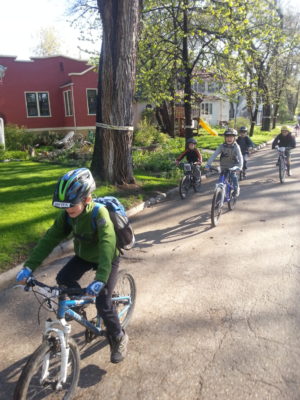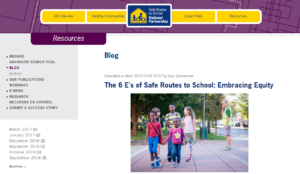On April 4, 2017, the City of Winnipeg announced the “Be Aware, Drive with Care” Campaign. Presented by Councillors Brian Mayes and Cindy Gilroy, the campaign involves two steps. The first is an awareness campaign, by which videos, graphics, and media releases will aim to increase awareness on the types of rights and violations drivers will need to be aware of in and around school zones. The second is enforcement, an attempt by the Winnipeg Parking Authority to ticket infractions in these zones and mail these tickets beginning May 1. Undoubtedly, this will also include more attempts by Parking Authority officers to go after these types of tickets in school zones. This approach requires parents who drive their children to school be more vigilant and respectful of school and parking rules.
 Our Active and Safe Routes to School program has been working on the ground for over a decade to support schools to make it both safe and practical for students to walk and bike. We do this through a variety of ways (see School Travel Planning), though most recently, we have been requested by the Winnipeg Police Service to assist in observing several schools during peak traffic times, and to make recommendations to improve student safety around schools. One issue is consistent throughout all of our work around schools: parking, and infractions during pick-up/drop-off are a major issue at almost every school we have studied. Through the BikeWalkRoll app, we can see that almost half of the students in Manitoba schools are typically driven to school, which directly correlates to major congestion around schools during drop-off and pick-up times. From our first-hand observations, this congestion produces no end of bad habits. Speeding, double-parking, blocked driveways, and reckless U-Turns in high traffic conditions are just some of the many serious issues we have personally witnessed during our walk abouts. Keep in mind, these are infractions that occurred with both our staff and school staff clearly marked and apparent, observing traffic patterns..
Our Active and Safe Routes to School program has been working on the ground for over a decade to support schools to make it both safe and practical for students to walk and bike. We do this through a variety of ways (see School Travel Planning), though most recently, we have been requested by the Winnipeg Police Service to assist in observing several schools during peak traffic times, and to make recommendations to improve student safety around schools. One issue is consistent throughout all of our work around schools: parking, and infractions during pick-up/drop-off are a major issue at almost every school we have studied. Through the BikeWalkRoll app, we can see that almost half of the students in Manitoba schools are typically driven to school, which directly correlates to major congestion around schools during drop-off and pick-up times. From our first-hand observations, this congestion produces no end of bad habits. Speeding, double-parking, blocked driveways, and reckless U-Turns in high traffic conditions are just some of the many serious issues we have personally witnessed during our walk abouts. Keep in mind, these are infractions that occurred with both our staff and school staff clearly marked and apparent, observing traffic patterns..
Councillor Mayes did address that there would be some backlash, citing people who would call this a “cash grab” by the city, and those allegations may not be completely without warrant. While some imagine that this will change behaviour, what isn’t addressed is the demand for drop-off options. This doesn’t mean parking necessarily. What Green Action Centre recommends to put this argument to rest, is to earmark any and all generated capital from this parking enforcement program towards increasing school capacity for multi-modal and active transportation methods for schools. This can include traffic assessments and improvements, but of course we would prefer to see development of better active transportation infrastructure, route assessments, and safety measures be installed. By providing more options that are just as convenient, if not moreso, to parents, the thought is they’ll be more likely to use them. This will result in less vehicles around schools, cleaner air, physically active kids, and lowered risk of injury to students.
But which schools should receive this funding first? We see an equity rubric and needs-based dialogue as necessary, which would be a tough thing to get completely right. But, we need to get to even having that conversation first – this would be a great step.
 The Safe Routes Partnership recognizes 6 E’s as effective tools for increasing safe routes to school: Education, Encouragement, Engineering, Enforcement, Evaluation, and Equity. These are internationally recognized strategies that have been adopted by Safe Routes to School organizations across the world, ours included. The City of Winnipeg’s “Be Aware, Drive With Care” campaign is part of the Enforcement strategy, and one that will certainly deter bad driving behaviours, and so we applaud the city in that regard. But to truly address the problem of vehicle congestion and air pollution around schools, this program will have to be supplemented with the other 5 E’s. There are some pretty easy strategies to activate these other safe routes strategies:
The Safe Routes Partnership recognizes 6 E’s as effective tools for increasing safe routes to school: Education, Encouragement, Engineering, Enforcement, Evaluation, and Equity. These are internationally recognized strategies that have been adopted by Safe Routes to School organizations across the world, ours included. The City of Winnipeg’s “Be Aware, Drive With Care” campaign is part of the Enforcement strategy, and one that will certainly deter bad driving behaviours, and so we applaud the city in that regard. But to truly address the problem of vehicle congestion and air pollution around schools, this program will have to be supplemented with the other 5 E’s. There are some pretty easy strategies to activate these other safe routes strategies:
- Education – Provide parents and schools with resources on local services and infrastructure that promote safe school travel. This includes active transportation routes and programming opportunities and skills development. This could be delivered at the Division level or by a needs-based assessment in schools.
- Encouragement – Students won’t practice safe travel habits if they aren’t encouraged to use them. Provide fun and interactive events that teach students how to be safe during their trip to school, as well as what facilities are in their neighbourhood that can help them experience this trip in a fun and safe way. This could be done with city-wide campaigns, or funding local organizations to provide these events.
- Engineering – Parents need to feel like alternative options are viable in order to use them. Assessing schools and making recommendations and adjustments to the surrounding built environment is integral to safe travel planning. Offering school divisions with knowledgeable experts in the engineering and planning professions to provide these assessments would be an appropriate first step, followed next of course with capital investments to safe routes infrastructure improvements.
- Evaluation – Schools that have the capacity to evaluate their own programming and assessing their level of success will help in ensuring their strategies to care for students as they get to and leave school actually works. What will assist in this is offering schools resources to build evaluation components into their school travel strategies, including providing assistance to start a school travel strategy if needed.
- Equity – Safe Routes to School is only successful if all students are able to participate. Ensuring that programming and funding is in place to include marginalized students and families must be provided. Further, schools should include an equity lens in their school travel strategic components.
Our Active and Safe Routes to School program’s mandate is to provide resources, programming, and expertise that can help schools and the city realize these recommendations. The “Be Aware, Drive With Care” is certainly a variant of one of the necessary steps of safe routes planning, so let’s round this campaign out with information on other programs that address the other 5 E’s, and fill those gaps that have yet to be implemented. Research has shown that without these other interventions described above being acted upon, the effectiveness of this campaign will be limited. If we truly want to address the issue of parking zone infractions in School Zones, lets address the root cause, and reduce the number of vehicles around schools, period. Our children will be happier, healthier, and more connected to their neighbourhood as a result.




Recent Comments